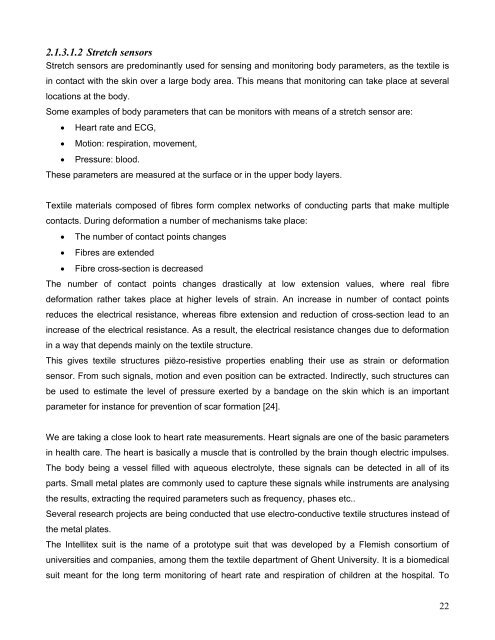Clevertex - Grado Zero Espace Srl
Clevertex - Grado Zero Espace Srl
Clevertex - Grado Zero Espace Srl
Create successful ePaper yourself
Turn your PDF publications into a flip-book with our unique Google optimized e-Paper software.
2.1.3.1.2 Stretch sensors<br />
Stretch sensors are predominantly used for sensing and monitoring body parameters, as the textile is<br />
in contact with the skin over a large body area. This means that monitoring can take place at several<br />
locations at the body.<br />
Some examples of body parameters that can be monitors with means of a stretch sensor are:<br />
• Heart rate and ECG,<br />
• Motion: respiration, movement,<br />
• Pressure: blood.<br />
These parameters are measured at the surface or in the upper body layers.<br />
Textile materials composed of fibres form complex networks of conducting parts that make multiple<br />
contacts. During deformation a number of mechanisms take place:<br />
• The number of contact points changes<br />
• Fibres are extended<br />
• Fibre cross-section is decreased<br />
The number of contact points changes drastically at low extension values, where real fibre<br />
deformation rather takes place at higher levels of strain. An increase in number of contact points<br />
reduces the electrical resistance, whereas fibre extension and reduction of cross-section lead to an<br />
increase of the electrical resistance. As a result, the electrical resistance changes due to deformation<br />
in a way that depends mainly on the textile structure.<br />
This gives textile structures piëzo-resistive properties enabling their use as strain or deformation<br />
sensor. From such signals, motion and even position can be extracted. Indirectly, such structures can<br />
be used to estimate the level of pressure exerted by a bandage on the skin which is an important<br />
parameter for instance for prevention of scar formation [24].<br />
We are taking a close look to heart rate measurements. Heart signals are one of the basic parameters<br />
in health care. The heart is basically a muscle that is controlled by the brain though electric impulses.<br />
The body being a vessel filled with aqueous electrolyte, these signals can be detected in all of its<br />
parts. Small metal plates are commonly used to capture these signals while instruments are analysing<br />
the results, extracting the required parameters such as frequency, phases etc..<br />
Several research projects are being conducted that use electro-conductive textile structures instead of<br />
the metal plates.<br />
The Intellitex suit is the name of a prototype suit that was developed by a Flemish consortium of<br />
universities and companies, among them the textile department of Ghent University. It is a biomedical<br />
suit meant for the long term monitoring of heart rate and respiration of children at the hospital. To<br />
22

















